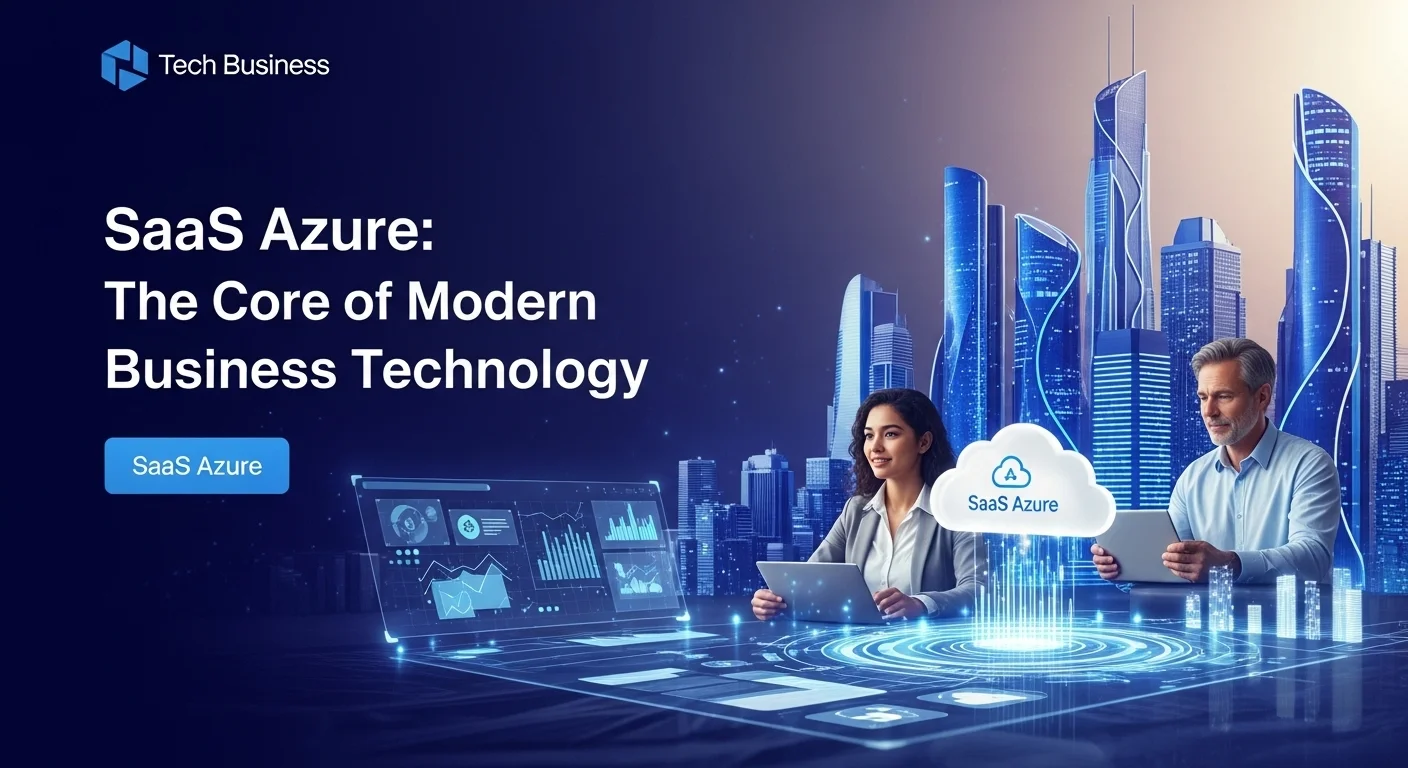SaaS on Azure: Your Practical Guide to IaaS, PaaS, and Building for the Cloud

Executive Summary
I've spent years in the cloud trenches, and if there's one thing I've learned, it's that understanding the cloud is key to business success. When we talk about cloud services, especially on a platform like Microsoft Azure, we often hear the terms IaaS, PaaS, and SaaS. It can sound like alphabet soup. This article is my attempt to cut through the jargon. We'll explore what Software as a Service (SaaS) on Azure really means for your business, break down the differences between the core service models, and see how they work together. My goal is to give you the practical knowledge to make smart decisions, innovate faster, and gain a real competitive edge.
Table of Contents
Table of Contents
- What is SaaS on Azure and Why Does It Matter?
- Breaking Down the Cloud Service Models: IaaS, PaaS, and SaaS
- The Real-World Importance of SaaS on Azure
- Building Your SaaS on Azure: A Practical Guide
- Business Strategy and Going to Market
- Pro Tips for Running a Successful SaaS on Azure
What is SaaS on Azure and Why Does It Matter?
In the world of business today, 'the cloud' is everywhere. It has completely changed the game for how companies run, grow, and create new things. At the core of this revolution are cloud service models, which are just different ways cloud resources are offered. Microsoft Azure is one of the biggest players, offering a massive toolkit of services that fit into three main buckets: Infrastructure as a Service (IaaS), Platform as a Service (PaaS), and Software as a Service (SaaS). Getting a handle on these Azure cloud models is the first step to a smart IT strategy. While they all have their place, SaaS on Azure is really the top of the pyramid. It delivers ready-to-use software right to your screen over the internet. This is so important because it hides all the messy technical details of servers and databases, letting businesses focus on what they do best. The power of SaaS on Azure is that it makes sophisticated software available to everyone, cuts down on huge initial costs, and gives you incredible flexibility to grow.
Breaking Down the Cloud Service Models: IaaS, PaaS, and SaaS
To really get why SaaS on Azure is such a big deal, you have to understand the layers it's built on. I've found that the best cloud solutions often use a mix of these models, balancing control with convenience. Think of it as a spectrum. Understanding the landscape of Azure's IaaS, PaaS, and SaaS offerings is crucial for building a solid cloud plan. Each model serves a different purpose, from raw computing power to a fully managed app.
Infrastructure as a Service (IaaS): The Foundation
IaaS is the most basic building block. With IaaS, a provider like Microsoft Azure rents you the fundamental computing infrastructure—servers, storage, and networking—from their massive data centers. I like to compare it to leasing a plot of land. You get the land, but you're responsible for building the house, putting in plumbing, and decorating it. With Azure IaaS, you manage the operating systems and software, while Microsoft handles the physical hardware. This gives you maximum flexibility and control, which is perfect for moving existing applications to the cloud (a 'lift and shift') or when you have very specific security needs. A classic example is an Azure Virtual Machine (VM), which is essentially your own server in the cloud.
Platform as a Service (PaaS): The Workshop
Moving up a level, we have PaaS. This model doesn't just give you the land; it gives you a fully equipped workshop. Azure provides the infrastructure plus the operating systems, development tools, and database management systems. All you have to do is show up and start building your product. For developers, this is a dream. It dramatically speeds up the creation process because you're not bogged down with maintaining the underlying platform. A great example in Azure is the App Service, which lets you build and scale web apps without ever worrying about the server it's running on. Another is Azure SQL Database, a managed database that handles all the tedious maintenance for you. Here, the difference between the Azure service models becomes clear: PaaS gives you less control than IaaS, but a lot more speed and efficiency.
Software as a Service (SaaS): The Finished Product
At the top is SaaS, the model most of us use every day. SaaS is software you subscribe to and access over the internet, usually through a web browser. With SaaS, the provider manages absolutely everything. Think of it like subscribing to Netflix or Spotify. You don't own the movies or the servers they run on; you just log in and enjoy the service. Microsoft 365 is a perfect example of a SaaS product built on Azure. You use Word and Excel without a single thought about software updates or server patches. The beauty of this model is its simplicity. It lets companies use powerful tools with predictable costs and almost no IT headaches. Many software companies build their own SaaS applications on Azure, using its IaaS and PaaS components as the foundation to deliver their products globally.
The Real-World Importance of SaaS on Azure
Adopting SaaS isn't just a tech upgrade; it's a smart business move. Building your application on Azure gives you a serious advantage through its powerful technology and business-friendly ecosystem.
Key Business Benefits
From a business standpoint, the SaaS model on Azure is a game-changer. First, it lowers the financial barrier. Instead of a massive upfront investment in hardware and licenses, you pay a predictable monthly or annual fee. This makes cutting-edge technology accessible to startups and small businesses. Second, it creates a stable, predictable revenue stream for the software provider, which is vital for growth. Third, these solutions are built to scale. As your customer base grows, an application built on Azure can automatically handle the increased demand, ensuring a smooth experience for everyone. This elastic nature is a core benefit of the Azure cloud. Finally, it helps you get your product to market faster. By using Azure's PaaS tools, your development team can build and launch applications more quickly, giving you a head start on the competition.
Technological Advantages of Building on Azure
Azure is an incredible platform for SaaS because of its advanced capabilities. Its global footprint is massive, with data centers all over the world. This means you can host your application closer to your customers for better speed and performance. Security is, of course, a top priority. Azure provides a layered security approach, with tools for identity management, threat protection, and secure data storage, helping you build a fortress around your application. The platform's commitment to compliance is also a huge plus, helping you meet industry and government regulations. And it doesn't stop there. Azure makes it easy to innovate by integrating technologies like AI and Machine Learning. You can add smart features to your app, like image recognition or predictive analytics, creating more value for your users. The real power is how these IaaS, PaaS, and SaaS services work together on a single platform, giving you the flexibility to build the perfect solution for your needs.

Building Your SaaS on Azure: A Practical Guide
Creating a successful SaaS application is more than just writing code; it's a marathon of smart planning across technology, architecture, and business strategy. Microsoft Azure offers a fantastic set of tools to help you run that race. In my experience, the best SaaS solutions don't just pick one cloud model; they artfully blend Azure's IaaS, PaaS, and SaaS services to get the perfect mix of control, cost-efficiency, and power. This guide dives into the practical methods for building a tough and scalable SaaS solution on Azure.
Architecting for Success: Multi-Tenancy
The secret sauce of most SaaS applications is an architecture called 'multi-tenancy.' It simply means that one single version of your software serves many different customers (or 'tenants'). How you design this is one of the biggest decisions you'll make. It affects everything: how you scale, your costs, security, and how you manage the whole thing day-to-day. Your choice here is directly tied to how you use the IaaS and PaaS models in Azure.
Choosing a Tenancy Model
There are a few ways to approach multi-tenancy, each with its pros and cons. The main question is always: how separate do my customers' data and resources need to be?
1. The Fort Knox Model (Fully Isolated): Here, every customer gets their very own dedicated set of resources. This could be their own Azure VM (IaaS), their own App Service plan, and their own database (PaaS). It offers the best possible security and isolation, but it's also the most expensive and complicated to manage. This is usually for big-ticket enterprise clients with strict rules to follow.
2. The Balanced Approach (Shared App, Separate Data): This is a very popular middle ground. You have one shared application that all customers use, but each customer's data lives in its own separate database. This gives you strong data isolation, which is a must-have for security. Azure SQL Elastic Pools are a perfect PaaS tool for this, letting you manage a bunch of separate databases efficiently.
3. The All-In Model (Fully Shared): In this pattern, every customer shares everything—the application and the database. It's the most cost-effective because you're using your resources to the max. However, it's also the most complex. Your developers have to be extremely careful to build security into the database itself to make sure one customer can never, ever see another customer's data. This model truly leverages the power of Azure's cloud synergy.
Key Azure Services for Your SaaS App
A modern SaaS app is like an orchestra, with different Azure services playing their parts. Here are some of the key players:
- Compute (The Engine): For your app's logic, Azure App Service is a brilliant PaaS choice for web apps. It handles scaling and deployments for you. If you're using containers (which is very common for modern apps), Azure Kubernetes Service (AKS) gives you a powerful, managed environment for a microservices architecture.
- Data Storage (The Brain): For traditional relational data, Azure SQL Database is a reliable workhorse. For more flexible, large-scale NoSQL data needs, Azure Cosmos DB is a global powerhouse that delivers data with incredible speed anywhere in the world.
- Identity (The Bouncer): Securely managing who can log in is non-negotiable. Azure Active Directory B2C is a complete identity solution that handles all the complexities of user sign-ups, sign-ins, and profile management, so your team can focus on building features.
Business Strategy and Going to Market
Having great tech is only half the battle. You also need a solid business plan. Azure doesn't just give you tools to build; it provides resources to help you sell.
Pricing and Billing Models
How you charge for your service is a core part of your business. Common models include:
- Flat-Rate: One price, one set of features. Simple.
- Per-User: The price goes up as a customer adds more users. Very common.
- Tiered Pricing: Offering different plans (like Basic, Pro, Enterprise) at different prices. This lets you serve a wider market.
- Usage-Based: Charging based on consumption, like how many API calls they make. This is how Azure itself works.
Implementing billing can be tricky. You need a reliable way to track usage. The Azure Marketplace offers tools and APIs to help streamline this entire process, from subscriptions to payments.
Leveraging the Azure Marketplace
The Microsoft Azure Marketplace is your gateway to a huge audience of potential customers, including most of the Fortune 500. Listing your SaaS app here can give your visibility a massive boost. When you make your solution available for purchase through the Marketplace, you can tap into Microsoft's own sales teams and co-selling programs. I've seen this partnership act as a rocket booster for growth. It's a perfect business application of the whole Azure ecosystem.

Pro Tips for Running a Successful SaaS on Azure
Launching your SaaS application on Azure is just the beginning. The real journey is about continuous improvement—making your service more secure, reliable, and cost-effective every day. It's a long-term game. To truly excel, you need a deep understanding of the entire Azure cloud spectrum, from IaaS to PaaS, because real optimization comes from using the right tool for the right job. Here are some of my go-to tips and strategies from years of working in the field.
Best Practices for Operations and Reliability
For any SaaS business, uptime is money and reliability is your reputation. Customers trust you to be there for them. The Azure Well-Architected Framework is your bible for achieving this.
Automate Everything with DevOps
If you're serious about SaaS, a strong DevOps culture isn't optional. Automation is your best friend—it brings consistency, slashes human error, and lets you release updates quickly and safely.
- Infrastructure as Code (IaC): Stop clicking around in the Azure portal to set up your production environment. Seriously. Use tools like ARM templates, Bicep, or Terraform to define your infrastructure in code. This makes your setups repeatable, consistent, and you can track changes to them just like you do with your application code.
- CI/CD Pipelines: Set up automated pipelines with Azure DevOps or GitHub Actions. Your pipeline should handle everything from the moment a developer commits code: building it, running all your automated tests, and deploying it smoothly to your different environments. This is fundamental to managing any professional cloud solution.
You Can't Fix What You Can't See
Proactive monitoring is the difference between finding a problem yourself and having an angry customer find it for you. You need eyes on everything.
- Azure Monitor: This is your command center for all monitoring in Azure. It pulls in metrics and logs from all your services, letting you track things like response times and error rates.
- Application Insights: This is a feature of Azure Monitor and, in my opinion, it's an absolute must-have. It gives you deep insights into your application's performance, automatically spots issues, and helps you diagnose bugs right down to the line of code.
- Centralized Logging: Funnel all your logs into a single Log Analytics workspace. This lets you run powerful queries to troubleshoot complex issues and uncover insights about how your system is behaving.
- Smart Alerting: Don't wait for the support tickets to roll in. Set up alerts in Azure Monitor to notify your team immediately—via email, SMS, or a Slack message—the moment something looks off.
Design for Failure
Things will break. It's inevitable. A resilient architecture is one that expects failure and knows how to recover gracefully.
- High Availability (HA): Don't put all your eggs in one basket. Deploy your app across multiple Availability Zones in an Azure region. These are separate data centers with their own power and cooling. If one goes down, your app keeps running.
- Disaster Recovery (DR): For your most critical systems, you need a plan for a whole region going offline. This means replicating your infrastructure and data to a secondary Azure region. Services like Azure Site Recovery can automate much of this process for you. Understanding how to build for resilience is how you earn trust.
Strategies for Security and Cost Management
In the cloud, security and cost are two sides of the same coin. A security breach can be financially catastrophic, and runaway costs can kill your business. You have to prioritize both.
Build a Fortress
Azure secures the cloud, but you are responsible for securing what's *in* the cloud. It's a shared responsibility.
- Identity is the New Perimeter: In the cloud, your main line of defense is controlling who gets in. Enforce multi-factor authentication (MFA) for everyone, especially your admins. Use Azure AD Conditional Access to create smart rules for who can log in from where.
- Network Security: Use Network Security Groups (NSGs) and Azure Firewall to act as gatekeepers, controlling the traffic that flows in and out of your networks.
- Encrypt Everything: Your data should be encrypted when it's moving (in transit) and when it's sitting still (at rest). Most Azure services do this by default, but you should also use Azure Key Vault to securely manage your application's secret keys and passwords.
Control Your Cloud Spend
Cloud bills can get scary if you're not paying attention. Cost optimization needs to be a constant habit.
- Right-Size Your Resources: I regularly see clients wasting money on oversized resources. Use tools like Azure Advisor to find and shrink or shut down underused services. Don't pay for power you're not using.
- Commit and Save: If you have predictable workloads (and most SaaS apps do), commit to them with Azure Reserved Instances or Savings Plans. By paying for one or three years upfront, you can save a huge amount compared to pay-as-you-go prices.
- Use Autoscaling: This is a key feature of PaaS services like App Service. Let your application automatically scale up to handle busy times and scale back down when it's quiet. You only pay for what you need, when you need it.
- Use the Billing Tools: Azure Cost Management + Billing gives you a detailed breakdown of your spending. Set budgets, create alerts for when you're getting close to them, and analyze your spending to find opportunities to save.
By putting these tips into practice, you'll be well on your way to running a world-class SaaS application on Azure. For more in-depth guidance, I always recommend the official Microsoft Azure Well-Architected Framework for SaaS; it's an invaluable resource.
Expert Reviews & Testimonials
Sarah Johnson, Business Owner ⭐⭐⭐⭐
As a small business owner, this was a helpful starting point. I wish there were a few more real-world examples of small companies using Azure, but it clarified the main differences for me.
Mike Chen, IT Consultant ⭐⭐⭐⭐⭐
Solid overview. As an IT consultant, I'm always explaining IaaS, PaaS, and SaaS to clients. This article does a great job, especially the section on multi-tenancy. A good resource to share.
Emma Davis, Tech Expert ⭐⭐⭐⭐⭐
Fantastic and thorough guide! It connected all the dots for me, from the high-level architecture down to the practical tips on cost management. This is exactly what I needed.



